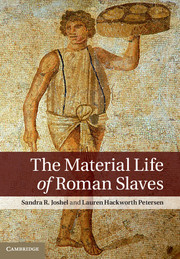Chapter 3 - Slaves in the City Streets
Published online by Cambridge University Press: 05 November 2014
Summary
“Isn’t this everyone’s Point of View?” asked Tock, looking around curiously. “Of course not,” replied Alec. . . . “It’s only mine, and you certainly can’t always look at things from someone else’s Point of View.”
—juster, The Phantom Tollbooth 1961, 107The ordinary practitioners of the city live “down below,” below the thresholds at which visibility begins. . . . They are walkers, Wandersmänner, whose bodies follow the thicks and thins of an urban “text” they write without being able to read it.
—de certeau 1988, 93This chapter begins with a unique and remarkable artifact – a terracotta tile that bears the footprints of two slaves, along with a bilingual inscription in Oscan and Latin (Fig. 66). The Oscan inscription reads “Detfri slave of Herennius Sattius / signed with a footprint,” and the Latin one, “Amica slave of Herennius / signed when / we were placing the tile.” The footprints function as signatures of a sort, but they also show something that is otherwise unrecorded, and largely unrecordable, in the remains of Roman cities – the literal footprints of individual slaves. These imprints were captured while the clay was soft, before the firing of the tile, leaving the slaves’ indelible footpaths as they traversed the tile. The reasons that this object merits mention are twofold. On the one hand, virtually no footprints from ancient Roman cities survive, and to have those of slaves is both unexpected and arresting. On the other hand, the tile was placed on the roof of the temple at Pietrabbondante, where no one could really see it and where footprints did not belong in any case. It is as if the footprints tactically claim a trace of existing, or better yet walking, a trace otherwise largely unrecognized in ancient and modern accounts of life in the city and on its streets.
- Type
- Chapter
- Information
- The Material Life of Roman Slaves , pp. 87 - 117Publisher: Cambridge University PressPrint publication year: 2014



